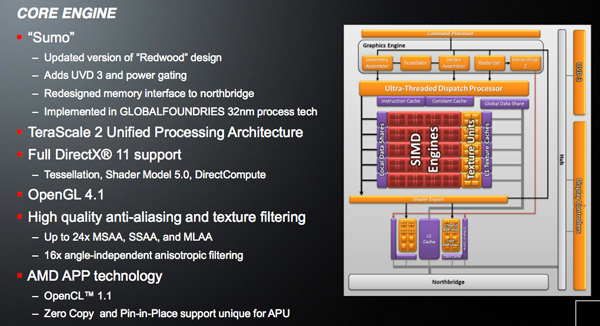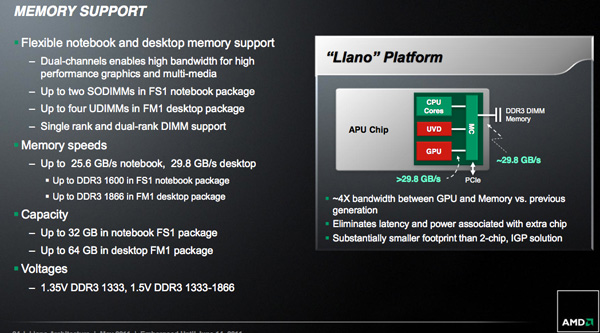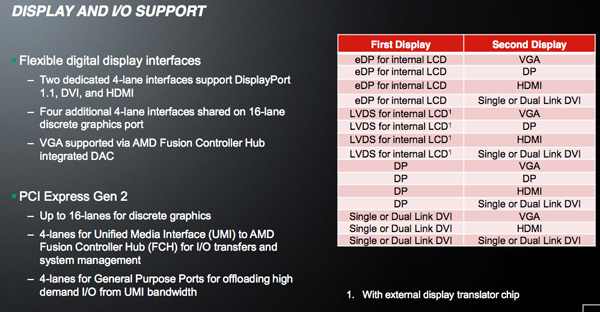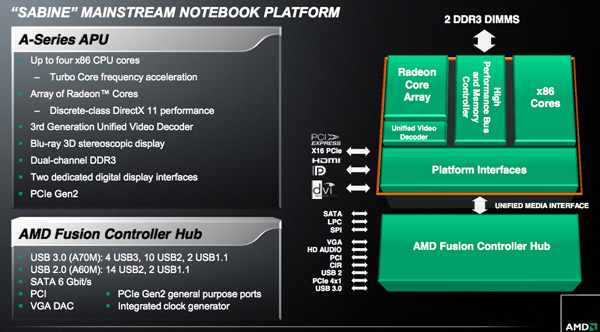The AMD Llano Notebook Review: Competing in the Mobile Market
by Jarred Walton & Anand Lal Shimpi on June 14, 2011 12:01 AM ESTThe GPU
While the Llano CPU cores may be in need of a major overhaul, Llano's GPU is as new as it gets. Technically based off of AMD's Redwood core (Radeon HD 5570) with some enhancements, Llano's GPU is codenamed Sumo.
The DX11 GPU features five SIMD arrays, each with 80 cores for a total of 400 shader processors. Similar to the updates we saw with this year's Northern Islands GPUs, Sumo does add UVD3 support to the Redwood architecture. Of course since Sumo shares the same die as the Llano CPU cores it is built on GlobalFoundries' 32nm process, making this the first AMD GPU fabbed at GlobalFoundries and not TSMC.
For everything behind the memory controller Sumo is virtually identical to Redwood. Where Sumo differs is in its memory interface. Although Llano is AMD's first performance oriented APU, it's still constrained by a 128-bit wide DDR3 memory interface. That dual-channel memory interface has to be shared by all four Llano cores as well as the Sumo GPU and as a result, arbitration is very important.
AMD shared a few choice details about the Llano memory controller architecture. To begin, AMD guarantees more than 30GB/s of bandwidth is available between the GPU and the memory controller—in other words, the path from GPU to the memory controller won't become a bottleneck. The GPU/memory controller link (i.e. within the APU die) can apparently scale up to as much as 50GB/s to support future APUs with even faster memory interfaces. Note that unlike previous integrated graphics solutions, there is no support for dedicated external memory—this is a pure shared memory architecture.
Second, and most importantly, AMD can dynamically prioritize memory bandwidth between the CPU and GPU. In most cases, when both processors are heavily consuming data, the GPU is given priority over the CPU. Given today's workloads, prioritizing the GPU for memory accesses makes sense when it's running full tilt. The chances of you stressing all four CPU cores and running at full GPU memory bandwidth requirements are pretty slim today.
With 400 shader processors behind a shared 128-bit DDR3 memory interface, the upper bound for Sumo performance is the Radeon HD 5570. In practice, you should expect performance to be noticeably lower since the GPU does have to share its precious memory bandwidth with up to four x86 CPU cores.
The mobile version of Llano supports up to DDR3-1600 while the desktop parts can run at up to DDR3-1866. Maximum memory capacities are 32GB and 64GB for notebooks and desktops, respectively.
Llano has a total of 24 PCIe Gen 2 lanes at its disposal. Sixteen of those lanes can be used for external graphics. Four of the lanes can be used for devices that need low latency/high bandwidth access to the APU itself (e.g. Gigabit ethernet). The remaining four lanes are used to connect the APU to its sole partner in crime: the Fusion Controller Hub.
AMD is particularly proud of the display output configurations supported by Llano. The possible combinations are listed below:
Chipsets
AMD will offer two Fusion Controller Hubs (FCHs) as options for Llano: A70M and A60M. The only difference between the two is in their support for USB 3.0; the A70M has four USB 3.0 ports while the A60M has none.
Both FCHs support 6Gbps SATA and perform just as well as AMD's 8-series chipset (or Intel's Z68) with a high performance SSD. USB 3.0 performance is also comparable to 3rd party solutions we've seen deployed on motherboards already.















177 Comments
View All Comments
whoaaaaaaaa - Tuesday, June 14, 2011 - link
A lot. I think you are very out of touch. No one buys desktops anymore, everyone uses a laptop - and quite a few people want to WOW or COD on them.luniq - Tuesday, June 14, 2011 - link
Agreed. A lot of people I know uses laptop although they rarely need to take it with them and they game too.swaaye - Tuesday, June 14, 2011 - link
I don't think he is. Most computer users don't play games. All they need is a GPU that can run the OS's UI.cotak - Tuesday, June 14, 2011 - link
The sort of people who use laptops and are pushing the CPUs hard are in the reality of the real world a limited bunch. Those who really need the power aren't going to be on a laptop anyhow like you say. Most office staff never use to the full potential of their issued computers even when they were using pentium 4s. And I actually think you'll find a lot of office workers are still humping around a P4 in their laptop bag.This is especially true as a lot of work now a days are done server side. About the only "office workers" who pound their CPU are those with big spread sheets. Even there I do not think you'll find many office workers who'd have an issue with most modern CPUs. They'll just go for a smoke or coffee break while it crunches.
And what review did you read that say there's no advantage in battery life? If you are pushing a game Llano lasts twice as long on the same battery.
voidi - Tuesday, June 14, 2011 - link
Lots of potential, they managed to find a valid niche in Intel's Netbook Hardware Portfolio. I think it's futile to argue about the success of this solution already, as the price will be the determining factor.As I see it, Llano has the potential to bring AMD back in the mobile market on a reasonable scale, but it also has the potential to utterly fail. Since it can't compete in the high-end area in either CPU or GPU performance, it will all depend on the value for your money. If the price is low enough, Llano will fill its niche quite comfortably.
Personally, I will wait for Trinity and Ivy Bridge, as both promise significant improvements and will likely be priced close to their predecessors.
jaydee - Tuesday, June 14, 2011 - link
On the one hand, I'm pleasantly surprised that AMD was able to bring the power draw of a K10/10.5 down to those levels, while adding decent GPU. It's a big step up for the to be in the discussion again for laptops. I don't think anyone could have reasonably expected them to go from Danube up to Intel's SB performance level overnight, so from that perspective, it's a big jump for them.On the other hand, it couldn't be more obvious that this product should have been competing against Arrendale about 18 months ago at the price point introduced today. I want to like this product badly, but it's so hard given it's CPU performance. Sure it's great for mid-range mobile gamers, but why would anyone else look at llano? Hopefully AMD can make just as big of a stride with BD-based mobile Fusion within the next 24 months, and then we can perhaps take AMD seriously in the bigger mobile market segments.
Gunbuster - Tuesday, June 14, 2011 - link
Will this mean the lowest common denominator HP $450 laptop of the week the everyone on a budget inevitably buys at retail when they are in a time crunch will suck less?I sure hope so.
Boissez - Tuesday, June 14, 2011 - link
I actually like the performance as it seems better balanced than in the dual-core Sandy bridges, ie., about 50% performancethe in single threads apps, 80% in multi-threaded apps and 200% in gaming. IOW better suited towards consumer needs. And battery life is good too.What AMD needs to work on though is lowering the TDP. A8-3500 performance in a 25W enveloppe would allow this to be a good alternative in the upcoming ultrabooks (especially because you can't fit a discrete GPU in those)
Boissez - Tuesday, June 14, 2011 - link
Oh yeah and make all of those APU's compatible with 1600 and 1866 Mhz RAM. RAM speed seems to be a major bottleneck in this platform.ET - Wednesday, June 15, 2011 - link
I think that even lower performance in 25W would be attractive, but it might eat into the E-350 market, unless it's priced significantly higher. I don't think it'd be a big problem for AMD to lower power to that point (certainly for A4), but they're probably waiting to see where the market goes with the current Llano APU's. I believe we'll see a 25W version later this year.